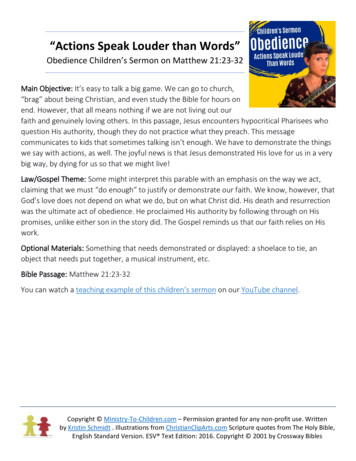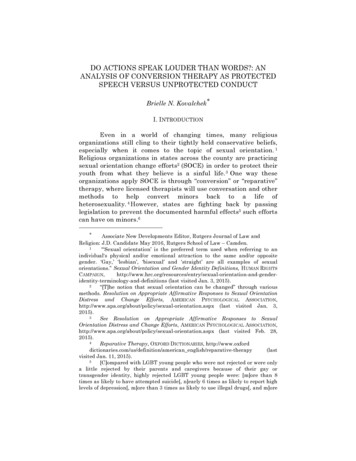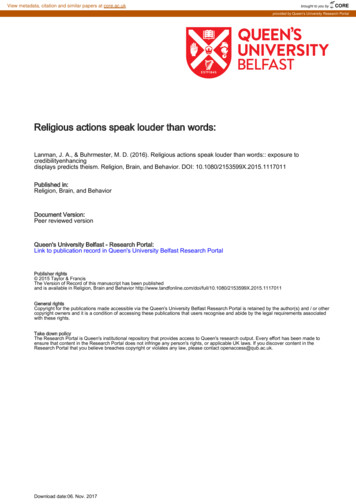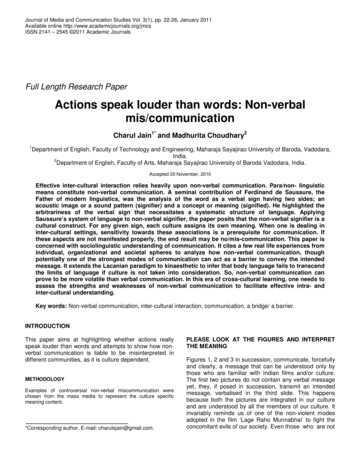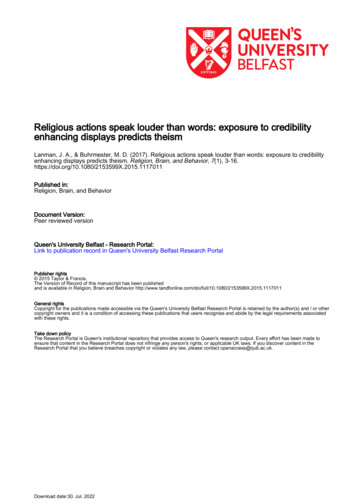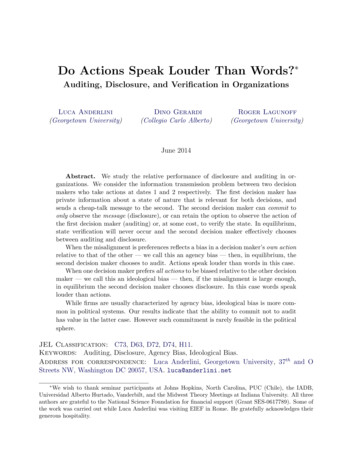
Transcription
Do Actions Speak Louder Than Words? Auditing, Disclosure, and Verification in OrganizationsLuca Anderlini(Georgetown University)Dino Gerardi(Collegio Carlo Alberto)Roger Lagunoff(Georgetown University)June 2014Abstract. We study the relative performance of disclosure and auditing in organizations. We consider the information transmission problem between two decisionmakers who take actions at dates 1 and 2 respectively. The first decision maker hasprivate information about a state of nature that is relevant for both decisions, andsends a cheap-talk message to the second. The second decision maker can commit toonly observe the message (disclosure), or can retain the option to observe the action ofthe first decision maker (auditing) or, at some cost, to verify the state. In equilibrium,state verification will never occur and the second decision maker effectively choosesbetween auditing and disclosure.When the misalignment is preferences reflects a bias in a decision maker’s own actionrelative to that of the other — we call this an agency bias — then, in equilibrium, thesecond decision maker chooses to audit. Actions speak louder than words in this case.When one decision maker prefers all actions to be biased relative to the other decisionmaker — we call this an ideological bias — then, if the misalignment is large enough,in equilibrium the second decision maker chooses disclosure. In this case words speaklouder than actions.While firms are usually characterized by agency bias, ideological bias is more common in political systems. Our results indicate that the ability to commit not to audithas value in the latter case. However such commitment is rarely feasible in the politicalsphere.JEL Classification: C73, D63, D72, D74, H11.Keywords: Auditing, Disclosure, Agency Bias, Ideological Bias.Address for correspondence: Luca Anderlini, Georgetown University, 37th and OStreets NW, Washington DC 20057, USA. luca@anderlini.net We wish to thank seminar participants at Johns Hopkins, North Carolina, PUC (Chile), the IADB,Universidad Alberto Hurtado, Vanderbilt, and the Midwest Theory Meetings at Indiana University. All threeauthors are grateful to the National Science Foundation for financial support (Grant SES-0617789). Some ofthe work was carried out while Luca Anderlini was visiting EIEF in Rome. He gratefully acknowledges theirgenerous hospitality.
Luca Anderlini, Dino Gerardi and Roger Lagunoff1.1IntroductionIn any ongoing organization there are two primary ways in which information is revealed. Oneis disclosure - transmission of information by the informed parties to uninformed receivers.Disclosure may be obligatory, but its content is determined by the informed sender and maytherefore be subject to manipulation. The other is auditing — the attempt by the uninformedparty to investigate or verify the information in some fashion. In this paper disclosure takesthe extreme form of cheap talk and auditing takes the extreme form of being able to observeexactly actions taken by others.This paper studies the relative performance of disclosure and auditing in a simple set-up.We consider a two-period policy setting framework in which the policy at each dateis chosen by a distinct decision maker. In period 1, the initial decision maker — DM1 (the“sender”) — chooses an action (a “policy”) and a cheap-talk message after privately observingthe realization of an underlying state variable that affects the preferences of both DMs. Inperiod 2, the second decision maker — DM2 (the “receiver”) — chooses a policy.The choices of possible information channels open to DM2 are as follows. She can chooseto commit to only observe DM1’s message, and she can do so before DM1 takes any actionor sends his message. Throughout we refer to this as the case of disclosure. The decision byDM2 of whether to make such commitment or not is then announced to DM1. If she choosesnot to commit, DM2 retains the option to observe DM1’s action — throughout, we refer tothis as auditing — or even to observe the state (at a cost) — throughout, we refer to thislast possibility as verification. Once period 2 arrives, DM2 “reaches power” and her actionis then taken.Despite its simplicity, we believe the model encapsulates a variety of scenarios in a stylizedway. It is standard practice in a firm, for instance, for a current managerial team with insideknowledge to provide a detailed prospectus of the company’s overall health periodically. Evenso, its policies, expenditures, and acquisitions may also be audited to provide some externalverification to outside shareholders and subsequent generations of managers.Governments operate in much the same way. A ruling political party holds some insideinformation (for instance, knowledge of the effects of a particular regulation) and is requiredto disclose what it knows or observes. A rival party eventually reaches power and must thenchoose to either accept the outgoing party’s words or instead investigate the outgoing party’spolicies and decisions.In both firms and governments, misaligned preferences between temporally separated
Do Actions Speak Louder Than Words?2agents (e.g., two managerial teams or two political parties) distort incentives away from fullinformation disclosure. In this sense our setup is related to the classic cheap talk environmentin Crawford and Sobel (1982) (henceforth “CS”). Their sender is our DM1, while DM2 istheir receiver. Unlike in the CS environment, policy decisions here are made by both playersand the receiver may choose to audit before taking her own decision.Our main concern is to study under what conditions disclosure will be used, and wheninstead will we observe reliance on auditing, or even verification, in equilibrium. The answer is nuanced and depends on the particular characteristics of the organization. Somewhatsurprisingly, we find that there are plausible conditions under which, in equilibrium, the uninformed party will choose to commit to rely solely on disclosure and forego all other options,even when auditing costs are zero and even when the state can in principle be observed atan arbitrarily small cost. Sometimes it is indeed the case that, counterintuitively, “wordsspeak louder than actions,” in fact even louder than direct verification of the informationthat drives the actions in the first place.It is self-evident that most auditing and investigative practices attempt to verify the policies of a decision maker rather than the underlying state directly. This is often because directstate verification is costly or impossible. Consider for instance, the United States Securitiesand Exchange Commission (SEC) regulators’ attempts to investigate insider trading. In mostcases, the regulators cannot possibly uncover the underlying knowledge of traders. Instead,the SEC looks for unusual trading patterns and/or price movements prior to a firm’s disclosure (Heim, 2011). Similarly, political audits of potential wrongdoing involve verification ofa politician’s behavior in order to assess “what did [he] know and when did he know it?”1In the model, verification by DM2 of the hidden state is costly, but not impossible. All ourresults hold when this cost is vanishingly small (lexicographic), and this is what we actuallyassume throughout. We believe that this strengthens our results when we find that wordsspeak louder than actions since it supplies a superior alternative, even though it is rarelyfeasible in practice.Our first result shows that even when the cost of direct state verification is vanishinglysmall, DM2 will never choose this option in equilibrium. Intuitively, if DM1 expects thestate to be verified directly, he would choose his most preferred first period policy tailored tothe state. But because his policy would fully reveal the state, then uninformed DM2 would1The quote refers to the famous question asked of President Nixon by Senator Howard Baker during theWatergate Hearings, 1973, p. 1476.
Luca Anderlini, Dino Gerardi and Roger Lagunoff3switch to the policy audit that has no cost.2 Consequently, effectively DM2 chooses betweenthe “words” (disclosure) and the “actions” (policy audit) of her predecessor, DM1.Ultimately, the choice between words and actions depends on the wedge in preferencesbetween the organizations’ members. We refer to this misalignment as the “bias” (followingCS) and examine two canonical cases. In the case of agency bias, the active decision makerprefers a higher (or lower) policy than his counterpart, the passive stakeholder. Arguably,many private firms conform to this case. This form of bias contrasts with the case of ideologicalbias whereby the first period decision maker always prefers systematically higher (or lower)policies than his second period counterpart, regardless of which party chooses or which periodthe choice is made. The ideological biases arise naturally in politics.With agency bias, DM2 will generally choose a policy audit. However, under large enoughideological bias, DM2 will choose to commit in advance to use only the disclosed information (DM1’s cheap talk message) and to forgo all subsequent audit and state verificationpossibilities.To gain some intuition for these results, we observe that equilibria without auditing willresemble those in standard cheap talk models (e.g. CS). That is, only partial revelation ofinformation occurs in equilibrium, and this is bad for DM2.When a policy audit occurs in equilibrium, DM1 chooses his action taking into accountboth its direct payoff effect, driven by the bias, and its signaling value driven by DM1’s preferences over DM2’s action in the second period. When the wedge between preferences takesthe form of an agency bias, these two effects roughly offset one another, thereby mitigatingthe effect of the sender’s bias. However, in the case of ideological bias, the direct payoff effectand the signaling value reinforce one another; both induce actions that are too large for therecipient. If the reinforced effect of the bias is large enough, the audit becomes undesirablefor DM2 who then avoids it in equilibrium. In fact, we show that forgoing auditing in favorof disclosure is not just preferable for the recipient, but it can be welfare enhancing for allparties.Our results suggest a paradox. In firms (where agency bias is prevalent), commitmentto forgo auditing may be possible though unnecessary because audits are always welfareenhancing. In political systems, audits often assume the form of a political investigation. Inthis case the commitment to forgo auditing is difficult or impossible, though it may be highly2Obviously this argument relies on state verification being more expensive than auditing the policy, noton the audit being free and the state verification having a vanishing small cost.
Do Actions Speak Louder Than Words?4desirable. Without such commitment, however, auditing will occur, and this may make allparties worse off.The remainder of the paper is organized as follows. Section 2 discusses related literature.Section 3 sets out the model. In Section 4 we characterize equilibria under both ideologicalbias and agency bias. Section 5 examines the robustness of the main results. Section 6concludes with anbrief discussion of the accountability systems found in firms and polities.All proofs are relegated to an Appendix to the paper. A prefix of “A” in the numbering ofequations and so on indicates that the relevant item can be found in the Appendix.2.Related LiteratureWe examine the equilibrium choice of disclosure or auditing by the uninformed agent.3 Withsome exceptions (discussed below) most of the literature examines either one or the othertransmission mechanism, but not both. Disclosure is the main focus of the cheap talk communication literature beginning with CS.4The present paper contains elements of dynastic cheap talk reminiscent of Spector (2000)and Anderlini, Gerardi, and Lagunoff (2012). Those papers examine the effect of bias amongmultiple decision makers and the incentives to disclose the contents of one’s objective signals(via cheap talk) to others in the temporal chain.Conditionally on DM2 not committing to disclosure, the present model is connected to thevast literature on signaling started by Spence (1973), since auditing involves the verification ofpayoff relevant decisions. A model related to ours in the signaling genre comes from Carrilloand Mariotti (2000) who examine a single agent problem with present-biased preferences.Given the bias, their model may be re-interpreted as a multiple agent decision problem — asin the present model. Their focus is on “voluntary ignorance,” i.e., when/whether an agentchooses to stop learning. In a sense, the present model also concerns voluntary ignorance— in this case by the receiver who might choose to commit to disclosure and hence not to“learn” from the sender. Daughety and Reinganum (2010) focus on a related question froma social welfare perspective. They examine a planner’s choice of protocol in a public goodsprovision problem between privacy rights of an individual and the social benefit of exposingfree riders. Our “words versus deeds” trade off somewhat resembles their “privacy versuspublic information” trade-off even though there is no (cheap talk) communication in the3A possible course of action open to DM2 is verification, but, as we noted above, it is relatively straightforward to rule out this possibility in equilibrium.4See Farrell and Rabin (1996), Sobel (2007), and Krishna and Morgan (2008) for surveys and references.
Luca Anderlini, Dino Gerardi and Roger Lagunoff5latter.A number of papers have looked at both cheap talk and signaling. Austen-Smith andBanks (2000) and Kartik (2007) allow the sender to choose among an array of both costlessand costly messages, the latter referred to as “money burning.” Their results demonstratehow the precision of cheap talk increases with the addition of the money burning option.Karamychev and Visser (2011) go a step further in giving a full characterization of theoptimal ex ante equilibrium for the sender in the model with both cheap talk and moneyburning. Kartik (2009) incorporates lying costs into the cheap talk model thereby turningcheap talk into costly signaling. He shows that equilibria exist exhibiting full separation incertain regions of the type space, something that is not possible in the standard CS modelwith a continuum of types.Our paper differs from these in that we examine the signaling value of policies rather thanthat of pure money burning. In this sense, the present paper is more related to Daughetyand Reinganum (2008) who study the endogenous choice of protocol by firms that attemptto reveal quality of their products. In their model, a firm can disclose quality through directclaims, or it can signal quality through its product choices.The main difference between these papers and ours is that we place the choice of communication protocol in the hands of the receiver rather than the sender or a planner. Whileprotocol decisions by the sender are quite natural in a market settings — firms vis a visconsumers — studied by Daughety and Reinganum (2008), Austen-Smith and Banks (2000)among others, we think it quite natural that the reverse would be likely within firms andgovernments where dynastic considerations play a role. In these cases, the actors fear theirpolicies may be undone by future decision makers if the information were revealed. Hencetheir actions would not ordinarily come to light unless an explicit audit makes it the case.3.The ModelThere are two Decision Makers — DM1 and DM2. The first has decision authority at timet 1 and the second at time t 2. The actions chosen by the two DMs in the two timeperiods are denoted by a1 R and a2 R respectively.3.1.PayoffsThe symbol θ R denotes the value of a state of nature that is drawn once and for all from f— a strictly positive continuous density over R — before anything else takes place. The four
Do Actions Speak Louder Than Words?6quantities bt,τ R with t 1, 2 and τ 1, 2 are a set of “bias” parameters that differentiatesthe payoffs of the two DMs — we refer to bt,τ as the bias of DMt in period τ .Each DMt with t 1, 2 has two period payoffVt (a1 θ bt,1 )2 (a2 θ bt,2 )2(1)Note that (1) implies that both DMs care equally about both periods in the chronology of theorganization. In Section 5 we return to this point and note that our main results go throughfor arbitrary discount factor δ (0, 1) applied to second period payoffs.To make our main points it suffices to consider only two possible values for each of thefour parameters bt,τ . Each of the bt,τ can be either equal to b 0 or to 0.5 Corresponding tothese two possibilities we will say that the payoff for a particular DM for a particular periodis “biased” or “unbiased” respectively.Differences in bias between the two players are the sources of preference misalignmentsbetween the two DMs. Hence, they are the key drivers of all equilibrium decisions in themodel. We consider two canonical cases.The first we call Ideological Bias. In this case we set b1,1 b1,2 b 0, and b2,1 b2,2 0.In other words, DM1 is biased in both periods, whereas DM2 is biased in neither of thetwo periods. DM1 systematically favors larger values of a1 and a2 relative to DM2.6 Ourterminology is motivated by the fact that the ideological bias model applies naturally topolitical environments, where an outgoing political party has systematically different policypreferences than its newly elected rival.We term the second canonical case Agency Bias. In this case b1,1 b2,2 b 0 andb1,2 b2,1 0. In this case the preference misalignment is driven by the role that each DMhas in each period: active policy maker or passive stakeholder. Each DM is biased for theaction that corresponds to the period in which he is the active policy maker, and unbiasedwhen he is a “passive stakeholder.” Our terminology in this case is motivated by the fact thatagency problems arise from the misalignment of preferences between someone who actuallycontrols a payoff-relevant variable (the agent, or the active DM in each period in our model)and a passive stakeholder who is affected by the choice but has no direct control over it (the5Given the quadratic form of payoffs in (1), picking one of the two values as 0 is just a normalization ofcourse.6The actual direction of the preference misalignment — DM1’s ideal point is larger than DM2’s — isclearly inessential.
Luca Anderlini, Dino Gerardi and Roger Lagunoff7principal, or, in our model, DM2 in period 1 and DM1 in period 2).The agency bias case captures the conflict within firms whereby a manager’s preferencesare misaligned with his or her successor or predecessor. The current manager, for instance,will have preferences over the use of managerial perks (say private jets), while a past managerwho holds stock options awarded during his tenure as a manager only has preferences formanagerial actions that induce stock-appreciation. The agency bias case can also apply topoliticians provided they are primarily office-motivated rather than ideologically driven.The biases of the the two DMs in the two periods in the two canonical cases we haveidentified are represented schematically below.τ 1 τ 2τ 1 τ 2DM1bbDM1b0DM200DM20bIdeological Bias(2)Agency BiasNote that in either the ideological or the agency bias case, as b 0 the conflict betweenthe players vanishes.Before proceeding further we illustrate with a simple application the case of IdeologicalBias. Consider a government’s problem of choosing its carbon emissions policy. The government faces turnover in its leadership. Specifically, two political parties take turns occupyingthe leadership position. In the first period, the “Carbon Party” occupies power, only to bereplaced in the second period by the “Green Party.” When in power, each party must choosea carbon emissions policy. The policy choice at may be interpreted as an attempt by therelevant political leader to hit a desired emissions target. The parameter θ then embodiesthe existing state of climate science. For any given θ, the Carbon Party that occupies powerfirst prefers the emission level θ b while then the Green Party prefers an emissions levelthat targets θ.7 We return to political turnover in Section 4 below.In the next subsection, we introduce the formal auditing model. The focus is on how thedegree of conflict — as represented here by b — distorts the incentives of decision makers ateach decision date.7This carbon emissions example is one concrete instance of the “political turnover” model. Others includeinflation targeting (θ is the inflation target) and anti-terrorism policy (θ is the threat level).
Do Actions Speak Louder Than Words?3.2.8Information, Auditing, and DisclosureCrucially, we assume that neither the state θ nor the first period policy is automaticallyobserved by DM2. Specifically, the state θ and the first period policy a1 are known only toDM1, unless DM2 makes it a point to verify them. DM2 therefore assumes power in t 2knowing only that θ is realized from a continuous strictly positive density f defined on R. Wewill sometimes refer to DM1 as the “informed agent” and DM2 as the “uninformed agent.”In the carbon emissions policy example, both the state of climate science θ and theemissions level a1 would be difficult to measure and, hence, are not automatically observedby anyone other than the party in power.After observing θ and choosing his policy a1 , the informed agent DM1 chooses a messagem R that can in principle be used to communicate or “disclose” something about the valueof the state θ. We refer to message m as DM1’s disclosure statement.Obviously, if the disclosure statement fully revealed the state θ, then DM2 would have noreason to investigate or otherwise expend any effort to verify the information. However, thebias creates a misalignment in preferences over the second period policy. Hence, just as inthe well known cheap talk environments, the message by DM1 will never be fully informative.Knowing this in advance, the uninformed DM2 has a choice before any policies or disclosure statements are undertaken. She can choose to rely exclusively on DM1’s message andthereby forgo any attempt to verify the information. Alternatively, she can hold open the option to seek additional information later on after the policies and disclosure occurred. We willrefer to options to investigate or verify as a policy audit and a state verification respectively.Formally, we let π {0, 1} denote the “commitment” choice of DM2. The choice π 1denotes the commitment by DM2 to forgo both a policy audit and state verification andhence to rely on m alone, while π 0 denotes “keeping ones options open.” Choosing π 0,DM2 chooses to exercise discretionary authority at a later date over what information shewill seek.If the uninformed agent opts for discretionary authority (π 0), she subsequently hasthree choices: (i) she can still choose not to audit, and therefore rely only on the message (wedenote this choice by NA for “no audit”), (ii) she can undertake a costless audit to verify thepolicy choice a1 of DM1 (we denote this choice by PA, for “policy audit”), or (iii) she canundertake a costly audit to verify the state directly (we denote this choice by SV, for “stateverification”). To simplify, we assume that both SV ad PA are “perfect.” State Verificationfully reveals the state θ, while a Policy Audits fully reveals the first period policy choice a1 .
Luca Anderlini, Dino Gerardi and Roger Lagunoff9We let the choice across these three possibilities be denoted by d so thatd {NA, PA, SV}(3)Other things equal, DM2 would clearly (weakly at least) prefer State Verification over aPolicy Audit since the state, not the prior action, is relevant to her policy choice in period 2.On the other hand, the act of verifying the state directly may be difficult or costly in manycommon situations. Moreover, the first period policy, while having no direct effect on thesecond period payoff, may nonetheless have signaling value for the decision makers. In otherwords, since θ affects DM1’s preferences over his choice of a1 , it is clear that a Policy Auditcan reveal information about θ.In order to create reasonable trade off between SV and PA, we assume that Policy Auditsare costless while State Verification carries a small cost.8 The cost will be so small, in fact,as to be lexicographic; this of course implies that State Verification is chosen unless DM1’saction at fully reveals the state θ. In this case a Policy Audit is (lexicographically) cheaperfor DM2 and since it is equally informative it will be chosen over SV.To summarize, temporally distinct decision makers (managers, political leaders, etc.) haveconflicting preferences about the ideal policy each period. Preferences are influenced by anunderlying state that is privately observed by the initial decision maker. The policy of DM1is not (immediately) observed by DM2. DM2 can choose whether or not to forgo the PolicyAudit and State Verification options and commit to observing only DM1’s cheap talk messagem. DM1 chooses his message and action after observing DM2’s commitment choice. If DM2does not commit, she can later choose between still only observing the message m (denotedNA), observing DM1’s action (denoted PA) and verifying the actual value of θ (denoted SV).The timing is depicted schematically below.8For our purposes, it matters only that PA should be is less costly than SV. The main results focus on thesurprising outcome that DM2 in equilibrium may commit to disclosure and foregoes PA and SV. So addinga cost to PA will only reinforce this result.
10Do Actions Speak Louder Than Words?θ RealizedDM2 ChoosesDM1 Choosesπ {0, 1}a1 R and m RIf π 0,DM2 Choosesd {NA, PA, SV}DM2 Choosesa2 RFigure 13.3.EquilibriumWe denote by z the actual observed outcome corresponding to the choice d at the discretionarystage. Specifically, z is the observed outcome when DM2 initially chooses no commitment(π 0) and then chooses d. Note that corresponding to the three possible values of d as in(3) z will be equal to m, a1 and θ respectively. If DM2 chooses π 1 instead, of course sheonly observes m. Since all three possible observed variables take values in R, a parsimoniousway to describe what DM2 observes overall, taking both her choice of π and d into accountis πm (1 π)z.We let a1 α1 (θ, π) denote the choice of policy by DM1 given his observation of θ andDM2’s choice of π. Similarly, we let m µ(θ, π) denote DM1’s choice of message m.We also let a2 α2 (π m (1 π)z) denote DM2’s choice of policy as a function of theactual value of the variable she observes given her choice of π and d.Throughout the rest of the paper, by equilibrium we mean a Perfect Bayesian Equilibrium(PBE) of the game at hand.Definition 1. Equilibrium: An equilibrium is a 5-tuple (α1 , µ, π, d, α2 ) such that1) DM1 chooses the pair (α1 , µ) optimally given her observation of θ and π and DM2’s(correctly anticipated) choice of d and α2 .2) DM2 chooses the triple (π, d, α2 ) optimally. In particular, π and d are chosen givenher beliefs about θ and her correct anticipation of DM1’s choice of α1 and µ. DM2’s choiceof α2 is similarly optimal, reflecting her updated beliefs after observing the actual value ofπm (1 π)z.3) DM2’s updated beliefs satisfy Bayes’ Rule wherever possible.We first establish a baseline partial characterization of equilibria that will be helpful forsubsequent results.
Luca Anderlini, Dino Gerardi and Roger Lagunoff11Proposition 1. Full Revelation Without Commitment: Consider any equilibrium in eitherthe ideological or the agency bias model. Suppose that the equilibrium has the feature thatDM2 chooses π 0, so that she does not commit to observing m only and has the option toconduct a policy audit or verify the state at a later stage. Theni) It must be the case that d PA so that DM2 in fact chooses a policy audit when giventhe option of doing so.ii) DM1’s choice of a1 α1 (θ, 0) of DM1 is fully revealing of the state θ.One significant implication of Proposition 1 is that in a world where the commitmentto forgo policy auditing and state verification is not possible, the uninformed agent wouldalways choose to undertake a policy audit. She would never rely on messages alone, and shewould never choose to verify the state directly.In the interest of brevity, we omit a full formal proof for Proposition 1. The argument isstandard and what follows is a sketch of the steps involved.Assume that in some equilibrium π 0. When DM2 chooses d it is not possible that shewill set d NA and only observe m. In this case, given that a1 is sunk, the model would boildown to a version of the CS world, and the message wold not be fully revealing of the state.Hence DM2 could deviate to setting d SV, observe θ and hence attain a higher payoff.Could it then be that DM2 sets d SV when given the chance? In this case DM1 wouldanticipate that his choice of a1 plays no (informational) role in DM2’s choice of a2 . HenceDM1 would simply choose an action that maximizes his τ 1 payoff, and hence his choiceof a1 would be fully revealing of the state. But since SV carries a lexicographic cost,9 if thechoice of a1 is fully revealing of θ, DM2 would then deviate to choosing PA. This is just asinformative as SV, but carries no cost.Hence, the only possibility is that DM2 chooses PA when given the chance. Could itbe that this is the case and DM1’s choice of a1 is not fully revealing of θ? If this were thecase, given that the cost of choosing SV is lexicographic10 DM2 would then gain by deviatingto choosing SV. This would give her more information and hence allow her to improve herpayoff. Hence, we conclude that in any equilibrium if π 0 is chosen then d PA is alsochosen by DM2, and fur
We study the relative performance of disclosure and auditing in or-ganizations. We consider the information transmission problem between two decision . Actions speak louder than words in this case. When one decision maker prefers all actions to be biased relative to the other decision maker we call this an ideological bias then, if the .

